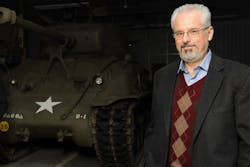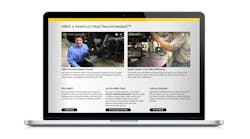Closing in on my graduation from Wayne State University in 1981, the economy in Detroit was in the doldrums because of recession. I was working, going to school, and, on the side, playing around with old cars. I was restoring a muscle car, and I found this business in Canada where I could get my parts. There, they keep cars on the road longer than we do. They have roadside inspections where an officer can sideline your car and check it. So there are businesses where you can get panels and floors so your older car can pass inspection.
I bought a pair of panels for the car I was rebuilding—a Road Runner Superbird, like Richard Petty drove with the big wing on the back. Before I could use them, I got busy with school, and so I sold them. I ordered the panels again from Canada, sold them again, and so next time, I bought two: One for me, one to sell. I sold both pairs again.
I decided I could start a mail order business this way. For one of my classes at the university, I wrote a paper about starting this business, and my professor said I should try it—before I knew too much about it and changed my mind. That was the beginning of what would become Sherman & Associates.
Business Basics and Hotrod
It got harder and harder to find new old stock (NOS), like a 1970 Road Runner OEM quarter panel that had never been used. Guys who are fussy about their rebuild projects would like to use NOS, but they’re very expensive. We’d find one that was never put on a car and buy it because we could replicate it. Now, we may acquire an entire automobile and digitize it if it’s never been in an accident. Rather than travel the world for swap meets to find a left quarter panel over there and something else over here, it’s easier to find the full car.
When we first came out with some of these products, we were at the forefront. It was very exciting: If you had a ’57 Chevy and the trunk floor was shot, we had the replacement. The business grew because all these guys that fix these cars are in clubs, and they talk. Somebody found our ad in the back of Hot Rod magazine; magazines started to write about us; a guy doesn’t know how to weld so he takes the part to a body shop, and the owner says, “Where the hell did you get this? The dealer hasn’t had this part in 15 years!” “Well this guy in Detroit has the parts,” the guy would say.
We’d get calls about parts, and that was our gauge for where to turn next and what parts to make. In the beginning, anything we could make, we sold, because the Big Three didn’t carry parts for past model cars. I’m no rocket scientist; I just noticed what rusted, and I’d remake those parts. I found a niche in the market, and then our name grew from there.
Twenty-five years after getting started, we have a very large customer base. Our mailing list is about 4,500. We sell to bump shops, dealerships, salvage yards, rental places. We’ll sell to anyone who wants to buy a part, let’s face it, but our regular customers are repeat in the trade. We have 65 employees in a 110,000-square-foot warehouse. My daughter and two sons work with me. Sarah is in management; Adam is in logistics in the warehouse, and Douglas is in sales. Both boys are still in college. I’m blessed with three amazing children.
Lots of Parts, Lots of Places
We stock about 25,000 part numbers. Back when I was restoring that Superbird, we stocked one part number for one car for rust repair. The part was common to many of the ’68 to ’70s Road Runners. Now, if you look at any crash book, they’ll offer seven or eight different grilles for the same package: with SE, without LE, black and silver, orange stripe. This proliferation of part numbers is terrible. For some particular Pontiac, we’ve got to stock four different bumpers and two different headlights. The capacity to stay up with all the different models is capital intensive.
Many different aftermarket companies make parts all over the world for companies like us. We have our own semis that go in and out of Canada. We have partners there who do the same kind of business, and we have similar phone and computer systems. Our stock is transparent to them, and vice versa. If my Focus bumpers are coming in late, but my partner has them, we swap stock, and he replenishes from my stock later.
We work together for economy of scale on things like catalogs and cardboard. The production runs on huge cardboard boxes are expensive, and to get costs down, we have to run 500 or 1,000 pieces at a time. We go in on an order with our partners; the split production run is good for both of us.
Hubs and Spokes
Back home in southeast Michigan and northern Ohio, we have 30 delivery trucks. The smaller trucks can go out and come back in a day. We have a distribution hub in Atlanta, and we work jointly with eight others. It becomes logistically cumbersome to move products over long distance. But when you’re moving hoods for Hondas and fenders for Ford Focus, you ship a lot of air. So we’re building hubs and star-fishing distribution out from there. During the next year-and-a-half, we’ll add several distribution facilities. We’ll also expand our warehouse. Most of our growth is in creating hub-and-spoke distribution centers.
There are only so many people who live here in Michigan, a finite amount of cars and people. To grow the business, it’s good to have product centralized where people can get to it.
American Made
We have some real car nuts here at Sherman & Associates and I’ve owned lots of automobiles. I don’t want to use something inferior on my pride and joy. Being here in Detroit, I can’t sell junk. All these Big Three autoworkers who do their own projects, they want something that fits when they repair their personal cars. We don’t like returns. It’s nice to make stuff in Detroit when we can—many of our suppliers are ISO rated and fantastic—but we can’t do it all. There’s not enough press capacity, and some low-production parts just wouldn’t be feasible because they wouldn’t be affordable for such short runs.
People just assume that all replacement parts are from overseas, but that’s not true. We are very proud of those parts we make here. That said, there are some suppliers here in Detroit that we don’t work with anymore, because they’ve gone out of business.
Jet Lag and Cross-Selling
Business never stops. We have vendors and suppliers and buying group people and partnerships all over. [On a recent morning], we had a meeting with someone who was awake in Taiwan and a guy in New Jersey, and of course we’re here in Michigan. We do a lot of sourcing in China—11 or 12 hours time difference—they never sleep over there.
You’re always getting into some conversation in the middle of the night: This product isn’t available, do you want to substitute, how many more cubic feet on the shipping container? You’re working on narrow margins, dealing with time delays and jetlag, cross-selling, taking advantage of special deals; and the first person to take advantage often gets the best deal.
The first replacement-parts industry was here, but as full assemblies came in, it was offshore. Overseas companies had the skills to make these products because the Big Three were sourcing things over there more often. It’s not like these are some back alley parts. One of these places I visited had a 400,000-square-foot headquarters, so that’s not exactly small. These companies are supported by other big industries, like refrigerator manufacturing.
SHHH … (Secrets for Success)
Without giving away the farm, we have a couple of new locations in the works. What we really sell here is service. We’re on a continuous mission to redesign and re-engineer this business to give better services because just about everything I sell can be bought somewhere else. We’re beefing up our computer systems so our wholesale customers can dial right in, check our stock, check their account and place orders. Behind the scenes, we’re working on phone systems and Wi-fi to keep our salesmen up to date so everyone has the data they need when they need it. You have to have the proper people on the bus in the right seats before you take on new business.
I oversee purchasing because that’s where all the money is—in inventory—and I’m still involved in product development, because I like that. I love automobiles. The bonus for me is that I get to get up every day and do what I enjoy for a living. I like my job, and the people I have with me, and the industry that I’m in. I do travel a bit, to Canada, back east, down south, and overseas. I’m basically steering the ship in terms of where we want to be. I’m still the idea guy. But today I’m working with my children and employees to develop the business into an organization that continues to set goals and is self-driven, with resiliency and creativity to prosper and grow without my intervention. A well-run and future-looking company cannot be driven by just one person—it is a huge team working for a common goal. Heck, I’m not going to be around forever. The sooner you realize that the better you are: build the system long before you are gone. Well-run companies continue to grow and prosper long after the founder is out of the picture.
Then There’s The Sherman Tank
I like complicated things that are powerful. I’d always wanted a Sherman tank. I am a Sherman. My grandfathers were involved in the war effort, and a distant relative is Roger Sherman, a signer on the Declaration of Independence. Plus, I am a big manufacturing kind of guy from southeast Michigan, and during the World Wars, Michigan built just about anything there was for the war effort, including tanks. So I got this tank—it took about five-and-a-half years to find—and restored it: I have a late-war-produced M4A1 76M Sherman tank. It weighs 72,000 pounds, and it’s a riot to drive. Where do I drive that thing? Wherever I want!
Still, I’m a pretty simple guy: I live on 20 acres, a pretty property that used to be a Christmas tree farm. I like to hunt; I like to visit with friends and family. I have a 6,000-square-foot garage that is like a playhouse for me. I’d like to design and build a house someday, but that’s about five years away.
Drive On
I drive an early ’07 Tahoe, and [as of November 2007] it has already about 66,000 miles on it. I’m starting to be more productive on the road, texting on the Blackberry and listening to books on CD. I’m listening to Good to Great [Why Some Companies Make the Leap and Others Don’t] by Jim Collins. It’s about building a culture in a corporation so it can prosper when the leadership changes hands or the leaders move on. It’s a helluva book.

